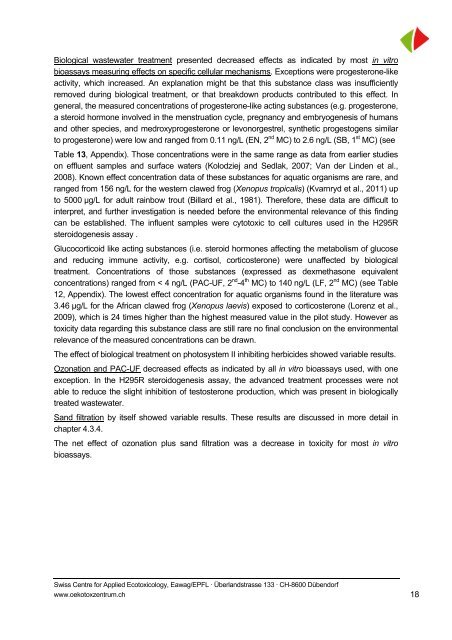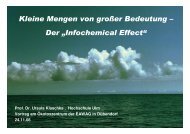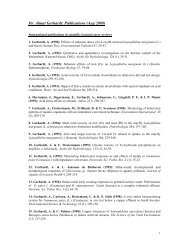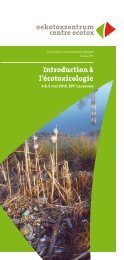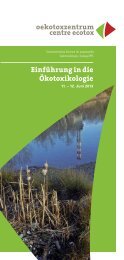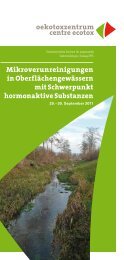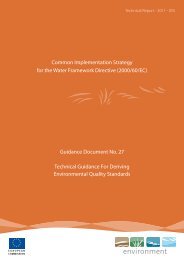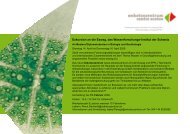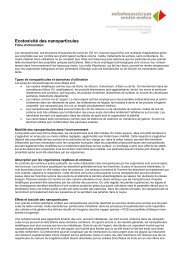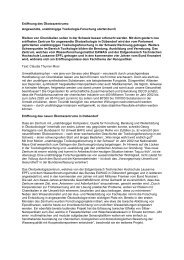Evaluation of Bioassays and Wastewater Quality ... - Oekotoxzentrum
Evaluation of Bioassays and Wastewater Quality ... - Oekotoxzentrum
Evaluation of Bioassays and Wastewater Quality ... - Oekotoxzentrum
You also want an ePaper? Increase the reach of your titles
YUMPU automatically turns print PDFs into web optimized ePapers that Google loves.
Biological wastewater treatment presented decreased effects as indicated by most in vitro<br />
bioassays measuring effects on specific cellular mechanisms. Exceptions were progesterone-like<br />
activity, which increased. An explanation might be that this substance class was insufficiently<br />
removed during biological treatment, or that breakdown products contributed to this effect. In<br />
general, the measured concentrations <strong>of</strong> progesterone-like acting substances (e.g. progesterone,<br />
a steroid hormone involved in the menstruation cycle, pregnancy <strong>and</strong> embryogenesis <strong>of</strong> humans<br />
<strong>and</strong> other species, <strong>and</strong> medroxyprogesterone or levonorgestrel, synthetic progestogens similar<br />
to progesterone) were low <strong>and</strong> ranged from 0.11 ng/L (EN, 2 nd MC) to 2.6 ng/L (SB, 1 st MC) (see<br />
Table 13, Appendix). Those concentrations were in the same range as data from earlier studies<br />
on effluent samples <strong>and</strong> surface waters (Kolodziej <strong>and</strong> Sedlak, 2007; Van der Linden et al.,<br />
2008). Known effect concentration data <strong>of</strong> these substances for aquatic organisms are rare, <strong>and</strong><br />
ranged from 156 ng/L for the western clawed frog (Xenopus tropicalis) (Kvarnryd et al., 2011) up<br />
to 5000 μg/L for adult rainbow trout (Billard et al., 1981). Therefore, these data are difficult to<br />
interpret, <strong>and</strong> further investigation is needed before the environmental relevance <strong>of</strong> this finding<br />
can be established. The influent samples were cytotoxic to cell cultures used in the H295R<br />
steroidogenesis assay .<br />
Glucocorticoid like acting substances (i.e. steroid hormones affecting the metabolism <strong>of</strong> glucose<br />
<strong>and</strong> reducing immune activity, e.g. cortisol, corticosterone) were unaffected by biological<br />
treatment. Concentrations <strong>of</strong> those substances (expressed as dexmethasone equivalent<br />
concentrations) ranged from < 4 ng/L (PAC-UF, 2 nd -4 th MC) to 140 ng/L (LF, 2 nd MC) (see Table<br />
12, Appendix). The lowest effect concentration for aquatic organisms found in the literature was<br />
3.46 µg/L for the African clawed frog (Xenopus laevis) exposed to corticosterone (Lorenz et al.,<br />
2009), which is 24 times higher than the highest measured value in the pilot study. However as<br />
toxicity data regarding this substance class are still rare no final conclusion on the environmental<br />
relevance <strong>of</strong> the measured concentrations can be drawn.<br />
The effect <strong>of</strong> biological treatment on photosystem II inhibiting herbicides showed variable results.<br />
Ozonation <strong>and</strong> PAC-UF decreased effects as indicated by all in vitro bioassays used, with one<br />
exception. In the H295R steroidogenesis assay, the advanced treatment processes were not<br />
able to reduce the slight inhibition <strong>of</strong> testosterone production, which was present in biologically<br />
treated wastewater.<br />
S<strong>and</strong> filtration by itself showed variable results. These results are discussed in more detail in<br />
chapter 4.3.4.<br />
The net effect <strong>of</strong> ozonation plus s<strong>and</strong> filtration was a decrease in toxicity for most in vitro<br />
bioassays.<br />
Swiss Centre for Applied Ecotoxicology, Eawag/EPFL · Überl<strong>and</strong>strasse 133 · CH-8600 Dübendorf<br />
www.oekotoxzentrum.ch<br />
18


